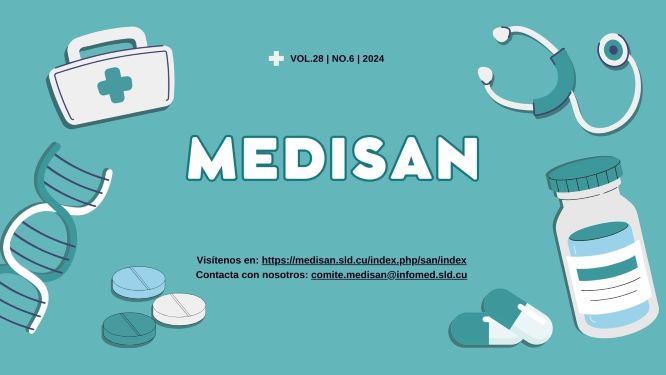Anatomical and tomographic characterization associated with clinical risk factors of patients with cranioencephalic trauma
Keywords:
brain trauma injury, risk factors, computerized axial tomography, Secondary Health Care.Abstract
Introduction: The cranioencephalic trauma is the mechanical aggression in consequence of which exists certainty or lesion suspicion in the brain and encephalic tissue.
Objective: To characterize the patients with cranioencephalic trauma from the anatomical and tomographic points of view, associated with clinical risk factors.
Method: A serial cases descriptive investigation was carried out on patients assisted in the Imaging Service of Saturnino Lora Teaching Clinical Surgical Provincial Hospital, Santiago de Cuba province, from January, 2021 to the same month in 2022. The study population was composed of 889 patients with cranioencephalic trauma, to whom a computerized axial tomography was carried out.
Results: There was a prevalence of the male sex (76.3 %), migraine (46.8 %), followed by several symptoms and signs (13.4 %), motor deficiency (11.5 %) and anisocoria (11.4 %). Brain contusion was the lesion that prevailed, being more frequent in the temporal, frontal and temporoparietal lobes, in that order. The type V focal lesion turned out to be that of more incidence.
Conclusions: This study provides an anatomical and tomographic characterization of patients with cranioencephalic trauma in connection with clinical risk factors. The findings obtained are of great relevance in the clinical context given the high incidence and mortality associated with this condition.
Downloads
References
2. Martín Roldán IL. Actualización en el diagnóstico y tratamiento del traumatismo craneoencefálico. NPunto. 2020 [citado 02/07/2024];3(25):43-54. Disponible en: https://www.npunto.es/revista/25/actualizacion-en-el-diagnostico-y-tratamiento-del-traumatismo-craneoencefalico
3. Temboury Ruiz F, Moya Torrecilla F, Arráez Sánchez MÁ, Arribas Gómez I, Vicente Bártulos A, Gallegos España FJ, et al. Traumatismo craneoencefálico leve y biomarcadores de lesión cerebral aguda. Rev Esp Urg Emerg. 2024 [citado 02/07/2024];2024;3:31-6. Disponible en: https://www.researchgate.net/publication/377307167
4. Caetano da Silva MI, Gomes da Silva RR, Santos Nogueira SH, Marcelino Lopes S, Moreira de Alencar R, Rodrigues Pinheiro W. Diagnósticos de enfermería para pacientes con traumatismo craneoencefálico: revisión integradora. Enferm. glob. 2021 [citado 03/07/2024];20(64):584-628. Disponible en: https://scielo.isciii.es/scielo.php?script=sci_arttext&pid=S1695-61412021000400584
5. Herrera Martínez MP, Ariza Hernández AG, Rodríguez Cantillo JJ, Pacheco Hernández A. Epidemiología del trauma craneoencefálico. Rev. cuban. med. int. emerg. 2018 [citado 03/07/2024];17(Suppl. 2):3-6. Disponible en: https://revmie.sld.cu/index.php/mie/article/view/540/539
6. Borja Santillán MA, Plúas Cobo KJ, Vintimilla Herrera BP, Rodríguez Orellana GG. Traumatismo craneoencefálico y complicaciones en accidentes moticiclisticos con y sin casco Hospital León Becerra Milagro 2018-2020. RECIMUNDO. 2021 [citado 03/07/2024];5(Especial 1):17-30. Disponible en: https://www.recimundo.com/index.php/es/article/view/1362/1870
7. Piñón García K, Montes Morales MN, Correa Borrell M, Pozo Romero JA, Almeida Esquivel Y. Factores de riesgo asociados a la mortalidad en pacientes con trauma craneoencefálico agudo. Rev. cuba. anestesiol. reanim. 2020 [citado 02/07/2024];19(3). Disponible en: http://scielo.sld.cu/scielo.php?script=sci_arttext&pid=S1726-67182020000300005
8. Ferreira A, Iramain R, Bogado N, Jara A, Cardozo L, Ortiz J, et al. Traumatismo craneoencefálico leve en el departamento de urgencias de pediatría del Hospital de Clínicas de San Lorenzo: características clínico epidemiológicas y frecuencia. Pediatr. (Asunción). 2021 [citado 02/07/2024];48(1):59-64. Disponible en: https://revistaspp.org/index.php/pediatria/article/view/624/530
9. Torres Criollo LM, Saquicela Salinas AS, Castañeda Goyes JM, Cruz Córdova KE. Traumatismo craneoencefálico. Medicina de Urgencia. 1 ed. La Plata: Puerto Madero; 2022. p. 333-357.
10. Capizzi A, Woo J, Verduzco Gutierrez M. Traumatic Brain Injury: An Overview of Epidemiology, Pathophysiology, and Medical Management. Med Clin North Am. 2020 [citado 03/07/2024];104(2):213-38. Disponible en: https://www.sciencedirect.com/science/article/abs/pii/S0025712519301294?via%3Dihub
11. V da Costa LG, C Carmona MJ, Malbouisson LM, Rizoli S, Rocha Filho JA, Galesso Cardoso R, et al. Independent early predictors of mortality in polytrauma patients: a prospective, observational, longitudinal study. Clinics. 2017 [citado 10/06/2024];72(8):461-8. Disponible en: https://www.scielo.br/j/clin/a/H6M6J49C9h5XQJnjFKHrwnq/?format=pdf&lang=en
12. Val Jordán E, Fuentes Esteban D, Casado Pellejero J, Nebra Puertas A. Actualización en el manejo de la hipertensión intracraneal tras un traumatismo
craneoencefálico. Sanid. Mil. 2023 [citado 03/07/2024];79(1):52-60. Disponible en: https://scielo.isciii.es/pdf/sm/v79n1/1887-8571-sm-79-01-52.pdf
13. Escamilla Ocañas CE, Albores Ibarra N. Estado actual y perspectivas futuras en el manejo de la hipertensión intracraneal posterior a traumatismo craneoencefálico: craniectomía descompresiva, hipotermia terapéutica y barbitúricos. Neurología. 2020 [citado 03/07/2024]. Disponible en: https://www.elsevier.es/es-revista-neurologia-295-avance-resumen-estado-actual-perspectivas-futuras-el-S0213485320302747
14. Craig W, Venkatakrishna R. Traumatic brain injury: Epidemiology, classification, and pathophysiology. UpToDate. 2021 [citado 05/07/2021]. Disponible en: https://www.uptodate.com/contents/traumatic-brain-injury-epidemiology-classification-and-pathophysiology
15. Shih RY, Burns J, Ajam AA, Broder JS, Chakraborty S, Kendi AT, et al. ACR Appropriateness Criteria® Head Trauma: 2021 Update. J Am Coll Radiol. 2021;18(5s):S13-36.
Downloads
Published
How to Cite
Issue
Section
License
All the articles can be downloaded or read for free. The journal does not charge any amount of money to the authors for the reception, edition or the publication of the articles, making the whole process completely free. Medisan has no embargo period and it is published under the license of Creative Commons, International Non Commercial Recognition 4.0, which authorizes the copy, reproduction and the total or partial distribution of the articles in any format or platform, with the conditions of citing the source of information and not to be used for profitable purposes.





